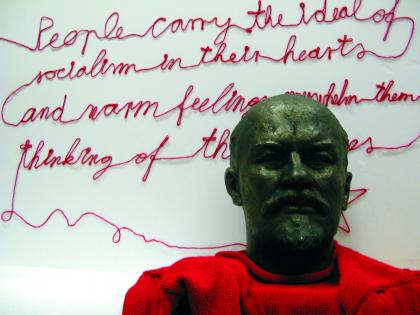Artists Interviews
March 2012: Jane Remm
Introduction
March/April Guest Editor Jane Remm: Interview with Annely Köster and Kerli Kehman
About the artist
The Contemporary Art Triennial for School Students Eksperimenta! (abbreviated to E!) is an international youth contemporary art event with an aim of bringing art and art education closer to each other. It consists of the Eksperimenta! triennial exhibition and IDEAlaboratory - an education and exchange programme and collaboration network of art schools and art centres.
Eksperimenta! is an ambitios undertaking with the aim of not only exhibiting young artists’ work but to bringing on changes in art education. The first Eksperimenta! took place in 2011, in Tallinn, being one of the key events in the programme of European Capital of Culture Tallinn.
What is the role of Eksperimenta!, how was the aim fulfilled and what are the impressions after the first triennial? I invited E! director Annely Köster and communication manager Kerli Kehman to share their impressions of the first triennial and discuss about Eksperimenta!’s role in the field of art education. The interview was conducted by e-mail.
About the project
Artwork from Eksperimenta!: Vantaa Art School (Finland), Gimme Space
Jane Remm (JR): What is the role of Eksperimenta! in the field of art and art education?
Annely Köster (AK): Just as the rest of the life that surrounds us, the essence of art, too, is changing more quickly than ever these days. If a young person who has graduated from secondary school is unable to understand contemporary culture, be it visual art, music or literature, it is certainly alarming. Not only in Estonia but also in many other countries, art education has reached a revolutionary state - we cannot carry on as before, because the art education provided in schools has hopelessly fallen behind the actual art practice. At the same time, there is no clear vision on how to proceed. A number of important questions have emerged that require discussions by a close circle of specialists as well as the general public. The purpose of the few art lessons provided in general education schools should be to guide students to see and analyse art, to teach them to recognize the network of relationships between art and different aspects of life. Eksperimenta! has been initiated in order to motivate young people and their teachers to deal with the themes of contemporary art and culture, and to offer an outlet for them.
Eksperimenta! general view – Installation shot of the triennial exhibition. Photo: Annely Köster
JR: The aim of Eksperimenta! is bringing art and art education closer to each other. How do you consider the first triennial fulfilled the aim?
AK: The first triennial was a surprise in a good sense - it surprised with the variety and high quality of expositions. The Slovenian exposition, which received the award for the best curatorial work, impressed, being credible as a whole if measured also by the so-called professional art world measurements, and could have been exhibited at whatever art event side by side with professional art work. You could also find equal work in all of the expositions. So, young people who participated got an authentic contemporary art experience from the point of view of the author. And many participating teachers had a reason to challenge themselves in the role of the curator, which forced them to rethink the role of art education and reckon more with what is happening on the contemporary art field.
Kerli Kehman (KK): As the feedback given by the visitors of 2011 triennial and art teachers, art theorists and curators who participated at the IDEAlaboratory conference revealed, there is a great need and anticipation for further activities of Eksperimenta!. By today Eksperimenta! has taken the first steps to position itself on the international art education field as an innovative and ambitious undertaking. The aim of further activities is to strengthen this position in Estonia and internationally.
After the first triennial we have a chose network of collaborators, which included art schools and art centres from 13 countries, with whom we organise workshops for sharing ideas also during the period between two triennial exhibitions.
During the first triennial we set up the platform for sharing the best practices in art education on E! web site, which was complemented by art education conference IDEAlaboratory, where art education professionals from 16 countries shared their practical and theoretical approaches to teaching contemporary art both at the level of secondary and higher education.
Zeynep Can Koray (Turkey) Space-less
JR: Almost a year has passed since the first Eksperimenta!. First impressions and feedback have settled. What would you like to bring out as a success? What was the biggest challenge?
KK: There were 13 participating countries, 19 curators, 844 young artists and more than 2000 m2 exhibition area filled with 400 art work in all kind of contemporary art media at the first Eksperimenta! triennial in 2011. Triennial was visited by more than 18 000 visitors. These are the numerical statistics of E!’s success.
For curators, E! was definitely valuable experience to try something totally new - we had curators who never worked with young people before, also, in their own words it was very difficult to leave out art several authors’ work, as there was a lot of good idea sketches, but inevitably the exhibition space set its limits.
For participants, i.e. young artists in the age range of 14 - 19, E! offered valuable experience to compare their art work with their peers from other countries, from other continents! E! also challenged young people to exhibit their art work following the rules of the professional art world (exhibition space was divided into so called national pavilions, which was based on the concept of each national curator and in the same time on the general topic of the triennial) and in the selection process young people had to be capable of conceptualizing their art work. Not to mention, that all the authors had to install or build their art work to the exhibition area either by themselves or through the mediation of the national curator.
For us, the organisers, it was on one hand a challenge to forecast how the exhibition as a body will finally work or merge. We pondered of including a general curator into the process, but decided this time to leave each country the freedom to compose their own whole set.
Another complicated, yet very important question in the point of view of the triennial as a whole and its sustainability, was questioning the methodology of teaching contemporary art in general schools - the aim and viewpoint of E! is that in contemporary society contemporary art must come closer to young people - learning contemporary art and ability to interpret it must become a natural part of growing up. During the first Eksperimenta! we took important steps (at least here in Estonia) to raise the topic of necessity of reforming art education in state institutions (general schools, educational ministeries) and professional media.

Ana Smerdu (Slovenia) Tissue of Socialism
JR: What makes Eksperimenta! sustainable?
KK: Firstly - functioning network of art schools, including representatives of professional associations, with whom discussions and actions are undertaken for conducting real changes in art education - for example suggestions for changing curricula, teacher training, initiating thematic discussions in media.
Secondly - The first successful triennial gave us as the organisers a confidence that an undertaking like E! is a very anticipated and necessary at the international field of young art. Almost all of the participants of 2011 triennial have expressed a wish to participate at the 2014 triennial and proposals to participate have came also from other countries, for example Brazil.
AK: Definitely people! Fanatic, venturous, creative, loving to cross borders. People to whom problems are rather challenges than limitation. And I am sincerely happy that the first E! brought us together with many great people all over the world, with whom we have a reason to meet again after a couple of years during the next Eksperimenta!
Installation view of the Irish exposition at Eksperimenta! 2011. Photo: Annely Köster
The Eksperimenta! team is starting to prepare the next, 2014 triennial. We are looking for new partners who are active in the field of art education, interested in connecting contemporary art and art education and interested in participating at the 2014 triennial. If you are interested in collaborating, please e-mail: info@eksperimenta.net. More information about Eksperimenta! can be found at: www.eksperimenta.net
Comments about this interview
Post your comment!
To comment this interview you must be logged.
- Guest Editor Katy Fitzpatrick on Bolthole by Rhona Byrne
- Art and Philosophy in the Classroom by Guest Editor Katy Fitzpatrick
- Jennie Guy in conversation with Guest Editor Katy Fitzpatrick
- Anne Bradley in conversation with Katy Fitzpatrick
- Priscila Fernandes in conversation with Katy Fitzpatrick - audio interview


No comments added